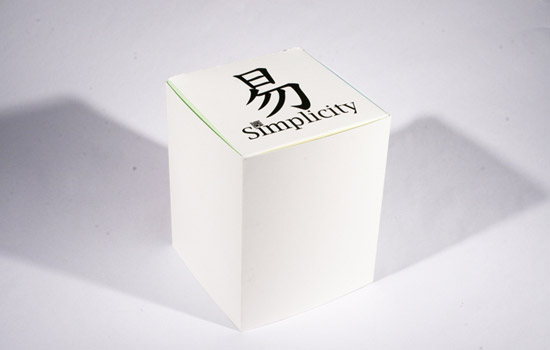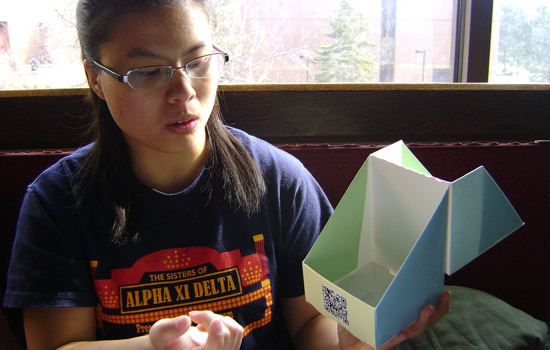Students’ design a finalist in national contest
Product package designed for point-of-sale and as docking station for mobile device
Michelle Cometa
Vivian Wong describes the different design features of the package she and Chad Krohn designed for the recent Paperboard Packaging Alliance Student Design Challenge. She and Krohn were named finalists for the collegiate competition.
Even though the package design is called Simplicity, it is anything but simple.
From the outside, it is a cream-colored box with a single graphic of the Chinese symbol for “simple.” But when it is opened, it can hold a mobile phone for a store display, and then transform with a single fold into a sturdy docking station.
The package and its designers, Vivian Wong and Chad Krohn, were named finalists in the recent 2011-2012 Paperboard Packaging Alliance Student Design Challenge. The two Rochester Institute of Technology students were among 50-plus entries from packaging science programs at U.S. colleges and universities participating in the annual design event. It was the first time Wong and Krohn entered the competition to design a package for a smart phone that would serve multiple functions beyond just housing the unit.
“We wanted simple graphics and outstanding features,” says Krohn, a third-year packaging science student from West Henrietta, N.Y. He and Wong worked 10 weeks on the project. The package consists of a paperboard dock to show off the phone, “feet” at the bottom to keep the box stable and three strategically-placed QR codes to connect the consumer to an online user’s guide. There is also a perforated section that can be removed to connect the recharging unit to the phone and wall outlet.
“The reason I wanted the Chinese symbol is to have our package be viewed as cultural, to embrace diversity and globalization,” says Krohn. “This is something we experience at RIT and most likely will in our future workplace.”
The students worked with RIT faculty member Bill Wynkoop ’87 to discuss not only the general use of the package but how it would need to be manufactured. “The students had an idea they wanted to execute and they were open to ideas, they were pretty flexible—that is something not everyone has,” he says. “Mentors are there to bounce ideas off of. We are the sounding boards, but the responsibility for the design is ultimately with the students.”
Wynkoop and Andy Gauvin ’05, a design engineer at Rochester-based Diamond Packaging, mentored the student participants as they designed a package-prototype, built a marketing plan and provided manufacturing schematics of the package as part of the contest.
“It was really helpful to think about the manufacturing aspect if you have many overlapping parts of the package structure,” says Wong, a third-year student from Brooklyn, N.Y. “It was enjoyable figuring it out. Part of the competition is the surprise element. This just looks like a plain box—who knew it would have another use?”
This project is considered an independent study, separate from class time, says Wynkoop, a lecturer in the packaging science program, part of RIT’s College of Applied Science and Technology. RIT is a three-time winner of the competition, now in its eighth year.
“Packaging is an art while being a science. It combines materials and machinery into creating something so special that most people take for granted,” says Krohn, who is on co-op at Teleflex Corp., a medical device company in Reading, Pa. “There is a lot you can do with this major for future jobs.”
Wong agreed: “Shopping centers and supermarkets are a packaging professional’s trophy case. The packages are created for a wide variety of products that are not only seen but used daily by consumers.”
 The graphic on the top of the package designed by Vivian Wong and Chad Krohn is the Chinese symbol for simple. It was used to symbolize the ease-of-use of the package as well as a way to embrace diversity.
ETC Photography
The graphic on the top of the package designed by Vivian Wong and Chad Krohn is the Chinese symbol for simple. It was used to symbolize the ease-of-use of the package as well as a way to embrace diversity.
ETC Photography














